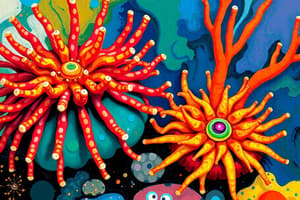Podcast
Questions and Answers
Identify 4 general examples of echinoderms.
Identify 4 general examples of echinoderms.
Sea stars, sand dollars, sea urchins, sea cucumbers
Differentiate the symmetry of adult echinoderms from that of their larvae stage.
Differentiate the symmetry of adult echinoderms from that of their larvae stage.
Adults are radially symmetrical; larvae are bilaterally symmetrical
Were early echinoderms able to move as adults?
Were early echinoderms able to move as adults?
False (B)
Because of adults being sessile, what evolved as a result?
Because of adults being sessile, what evolved as a result?
How many species of echinoderms are still sessile?
How many species of echinoderms are still sessile?
What characteristic makes echinoderms different from all other invertebrates?
What characteristic makes echinoderms different from all other invertebrates?
Are echinoderms more closely related to us or other invertebrates? Justify your answer.
Are echinoderms more closely related to us or other invertebrates? Justify your answer.
Identify the four major characteristics of echinoderms.
Identify the four major characteristics of echinoderms.
What is the meaning of the name Crinoidea?
What is the meaning of the name Crinoidea?
What is the meaning of the name Ophiuroidea?
What is the meaning of the name Ophiuroidea?
What is the meaning of the name Echinoidea?
What is the meaning of the name Echinoidea?
What is the meaning of the name Holothuroidea?
What is the meaning of the name Holothuroidea?
What is the meaning of the name Asteroidea?
What is the meaning of the name Asteroidea?
Name examples of echinoderms in class Crinoidea.
Name examples of echinoderms in class Crinoidea.
Name examples of echinoderms in class Ophiuroidea.
Name examples of echinoderms in class Ophiuroidea.
Name examples of echinoderms in class Echinoidea.
Name examples of echinoderms in class Echinoidea.
Name an example of an echinoderm in class Holothuroidea.
Name an example of an echinoderm in class Holothuroidea.
Name an example of an echinoderm in class Asteroidea.
Name an example of an echinoderm in class Asteroidea.
Trace the flow of water through the Water-vascular system (WVS).
Trace the flow of water through the Water-vascular system (WVS).
What are general characteristics of class Asteroidea?
What are general characteristics of class Asteroidea?
How do podia operate?
How do podia operate?
Which one is bigger, the cardiac or the pyloric stomach?
Which one is bigger, the cardiac or the pyloric stomach?
Explain the nutrition of organisms in class Asteroidea.
Explain the nutrition of organisms in class Asteroidea.
What are additional characteristics of class Asteroidea?
What are additional characteristics of class Asteroidea?
What are general characteristics of class Echinoidea?
What are general characteristics of class Echinoidea?
Flashcards are hidden until you start studying
Study Notes
General Echinodermata Characteristics
- Examples include sea stars, sand dollars, sea urchins, and sea cucumbers.
- Adult echinoderms exhibit radial symmetry, while larvae are bilaterally symmetrical.
- Early echinoderms were sessile as adults, which led to the development of radial symmetry.
- Approximately 80 species of echinoderms remain sessile today.
- Unique characteristic: echinoderms are deuterostomes, linking them more closely to vertebrates than to other invertebrates.
Major Echinodermata Features
- Four key characteristics:
- Pentaradial symmetry, where body parts extend from the center along five spokes.
- Ossicles, the calcium carbonate plates forming the endoskeleton, sometimes protruding through the skin.
- Water-vascular system, a network of water-filled canals aiding locomotion and feeding.
- Tube feet, small extensions for movement, feeding, respiration, and excretion.
Echinoderm Diversity
- Total number of echinoderm species is around 7,000.
- Five major classes of echinoderms:
- Crinoidea (e.g., sea lilies, feather stars) - meaning “lily-like”
- Ophiuroidea (e.g., basket stars, brittle stars) - meaning “snake-like”
- Echinoidea (e.g., sea urchins, sand dollars) - meaning “spine-like”
- Holothuroidea (e.g., sea cucumbers) - meaning “water polyp”
- Asteroidea (e.g., sea stars) - meaning “starlike”
Water-Vascular System (WVS)
- Water circulates through the WVS via the following path: madreporite → stone canal → ring canal → radial canal → lateral canal → ampullae → tube feet.
Class Asteroidea Characteristics
- Typically possess five arms merging with a central disk.
- The mouth is located on the central oral surface facing downward.
- Podia operate by fluid movement: the ampulla contracts, extending the podia. Suckers grip the substrate, the podia then retract, pulling the body forward.
- Nutrition involves a two-part stomach system: cardiac (larger) and pyloric, leading to digestive glands in each arm.
Additional Class Asteroidea Features
- Endoskeleton comprises calcareous plates (ossicles) and spines, with gas exchange facilitated by papulae.
- Pedicellariae serve as jaw-like appendages for various functions.
General Class Echinoidea Characteristics
- Members lack arms and exhibit a rounded body shape.
Studying That Suits You
Use AI to generate personalized quizzes and flashcards to suit your learning preferences.




